Nesting or hoarding? How to offer help.
Reading Tim: 5 minutes
We no longer call it hoarding or call a person a hoarder. Now we refer to it as hoarding disorder and a person with a hoarding disorder. There is much more respect for the journey being travelled by the person with a hoarding disorder.
Much is still not completely understood about hoarding disorder. Is it genetic, is it learned behaviour, is it caused by a mental wellness issue that triggers it? Is it a combination of all of these?
Making Peace with the Things in Your Life
In Making Peace with the Things in Your by Cindy Glovinsky, she writes about the internal battles of guilt and shame and by making peace with those a person can make peace with their things. She talks about figuring out what is going on in the person’s life so they can figure out why they are doing what they are doing. Part I talks about assumptions, Part II looks at habits and feelings, Part III describes possible causes of dealing with things and solutions and Part IV looks at ways to detach oneself from automatic emotional responses that perpetuate cycles of clutter.
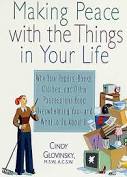
Cluttered Pearls The Stigma of Hoarding
This 2013 article takes a close look at the many different types of behaviours involved in hoarding. The information is still true today. I hope you enjoy this perspective written by Jean Oliver http://www.nexusnewspaper.com/2013/01/24/cluttered-pearls-the-stigma-of-hoarding/
Hoarding Scale
The Institute of Challenging Disorganization is a resource for many different types of organizational problems including hoarding disorder. They developed the ICD® Clutter-Hoarding Scale® that is based on five levels of clutter. 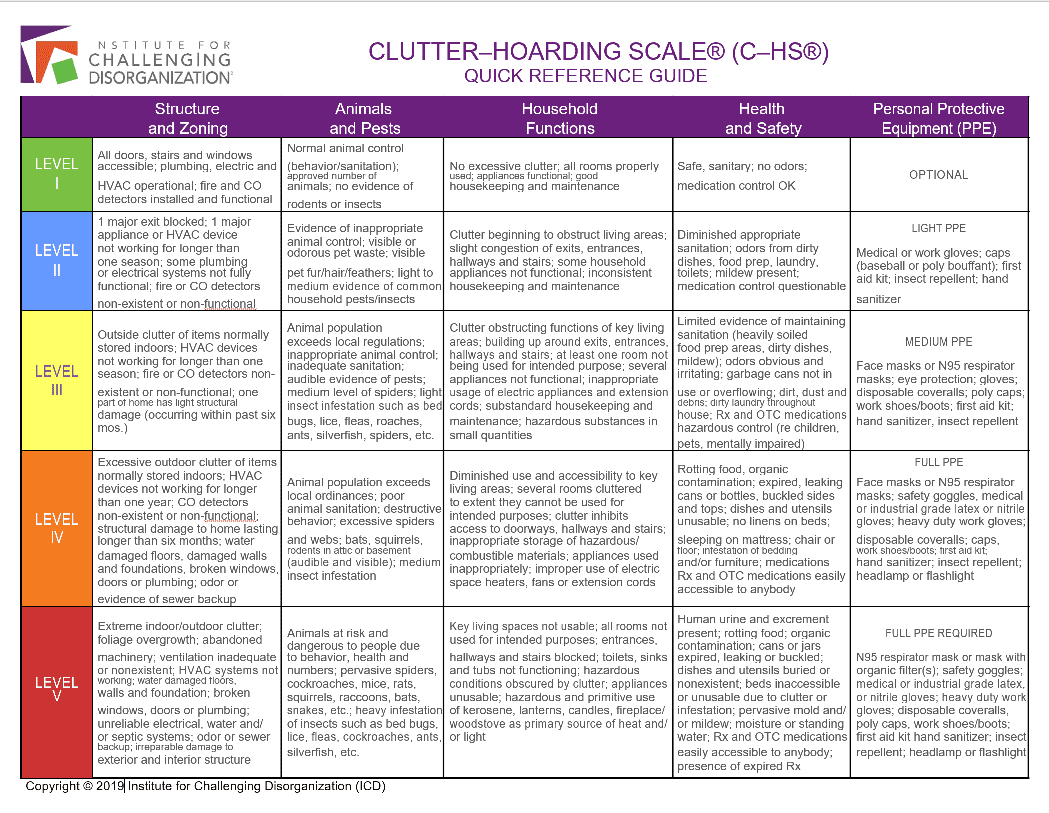
Clutter Image Rating
The Clutter Image Rating scale (with 9 levels/photos) was created by Dr. Randy Frost and Dr. Gail Steketee. They are experts in the field of hoarding. Their books are a good resource.
Offering Help
A lot of times a friend or family member will offer help. Too often the person thinks it would be better for the friend with a hoarding disorder to have a less cluttered space. The help is usually offered in a well-meaning manner. If the person with the hoarding disorder is not ready to change, progress will not be made or if some is made it will not be a lasting change. Talk to them about what they want and need. It may be to join a group for peer support in conquering their hoarding habits, working with a therapist or working with a Professional Organizer. The journey of changing habits and conquering shame is long but worth the time, energy and support you can give them.
Did I miss anything? Let me know in the comments about your hoarding disorder journey.
 Julie Stobbe is a Trained Professional Organizer and Lifestyle Organizing Coach who brings happiness to homes and organization to offices, coaching you virtually using Zoom. She has been working with clients since 2006 to provide customized organizing solutions to suit their individual needs and situations. She uses her love of physical activity to reduce clutter, in your home and office. She guides and supports you in managing your time. If you’re in a difficult transition Julie can coach you to break free of emotional clutter constraining you from living life on your terms. Get started by downloading Tips for Reorganizing 9 Rooms.
Julie Stobbe is a Trained Professional Organizer and Lifestyle Organizing Coach who brings happiness to homes and organization to offices, coaching you virtually using Zoom. She has been working with clients since 2006 to provide customized organizing solutions to suit their individual needs and situations. She uses her love of physical activity to reduce clutter, in your home and office. She guides and supports you in managing your time. If you’re in a difficult transition Julie can coach you to break free of emotional clutter constraining you from living life on your terms. Get started by downloading Tips for Reorganizing 9 Rooms.
Contact her at julie@mindoverclutter.ca
X – Facebook – Facebook group Organizing Mind and Space
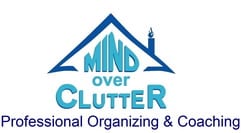
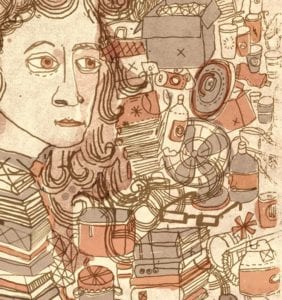
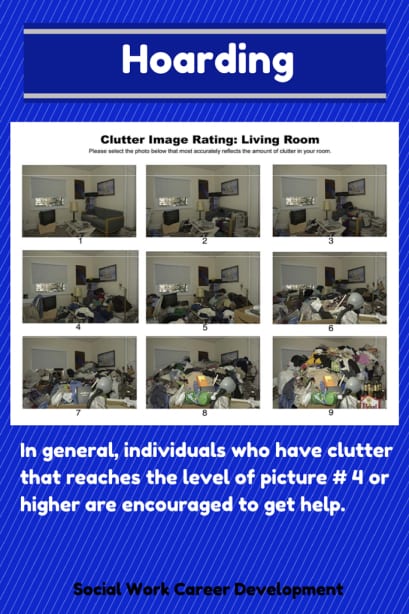
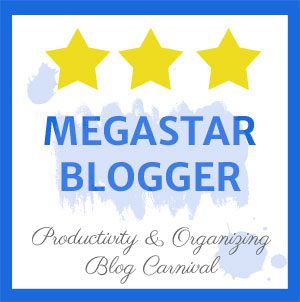
I think the change in the way we talk about people with hoarding disorder is small, and yet so important. It is a battle that a person is fighting, not the definition of who they are. Thanks for sharing these resources. The more we can bring any problem out into the light, the easier it is to manage it.
Thanks for your comment. I really appreciate your statement, “It is a battle that a person is fighting, not the definition of who they are.” You are so right.
I love the sensitivity you brought to this topic, especially about respecting how we refer to hoarding behavior. There is already so much shame around it, so being aware of language usage is important.
Cindy’s book I read many years ago and remember how dense and useful it was. It’s been a while, and seeing your review made me want to revisit it.
ICD is an amazing resource. They developed the ICD® Clutter-Hoarding Scale® that is based on five levels of clutter, and the ICD® Clutter Quality of Life Scale for Professional Organizers.
The Clutter Image Rating scale (with 9 levels/photos) you shared was created by Dr. Randy Frost and Dr. Gail Steketee. While Frost and Steketee have presented workshops for ICD, their scale is their own and is not an ICD product.
Thank you so much for clarifying about the Clutter Image Rating Scale. Dr Frost and Dr. Steketee are experts in this field and their books are a fantastic resource.
Thank you for the information about the 2 different hoarding scales. I have made the appropriate changes to the article. Dr. Frost and Dr. Steketeee are experts in the field and their books provide good information for family members and the person with hoarding disorder.
I really like the way you talk about the hoarding disorder as being a component of the person and not the definition of who they are. In our book: Filled Up and Overflowing: what to do when life events, chronic disorganization, or hoarding go overboard Jonda Beattie and I offer lots of suggestions of ways family and friends can sensitively help someone battling hoarding-like behaviors.
Thank you for sharing your book. It is so important to have resources available to discern the best pathway.
While I have never worked with hoarding clients, I am so glad the term changed to hoarding disorder from hoarding. The word hoarder has become a judgment, usually in a joke and other online memes. Hoarding is complex; it should be called a disorder. I don’t know of any disorders that are not complicated.
Hoarding is very misunderstood. Sometimes people who own a lot of stuff will ask me if they are a hoarder. Their word, not mine. I will reassure them that they can still use their space in the way it is meant to be used and they don’t have a hoarding disorder. Then we talk about why they have trouble letting go of things.
Great collection of resources, Julie! It’s a complex situation and the move towards a more respectful way of talking about it is very welcome. Those looking for help from a professional organizer would be well advised to check out the “find an organizer” link on http://www.challengingdisorganization.org. Organizers who belong to this association have access to ongoing training focused on better helping working with people who struggle mightily with their stuff.
Thank you for providing the link to find qualified Professional Organizers that can help. You can also go to Professional Organizers in Canada Find an Organizer and click on the Special Needs options https://organizersincanada.com/get-organized/find-an-organizer
This is really helpful info. I never really thought of the word “nesting” as the alternative most people deal with. Without fail, many clients tell me they think they’re a hoarder. I try and explain that true hoarding is something that requires careful professional evaluation and support. It’s usually determined that these clients aren’t actually hoarders. These are great clarification points to consider!
It is difficult to separate out the many reasons people have a lot of “stuff”. Understanding the situation properly is the key to being able to help in a way that provides lasting solutions.
I didn’t know that the term hoarding had changed. I would never call someone a “hoarder” but sometimes individuals I work with will self identify in that way. I am going to go back and read the article that is linked. Looks interesting.
Information about hoarding disorder is always changing. There is so much new information, it is hard to keep up with all the changes.
This is such a sensitive topic and I know it’s painful for anyone struggling with a hoarding disorder. I really like the gentleness in which you expressed yourself.
Your resources are terrific, that’s quite a list! I could have used these resources a while back. I understood that this disorder was not within my expertise. I really needed referrals who could help my clients.
A professional organizer needs to know their strength. I am glad you refer clients with hoarding disorder to other organizers. It means you are a good organizer with your client’s needs put first.
I love how you wrote this, Julie, with a gentle encouragement for people to learn more and not to judge. Hoarding disorders are just one component of a person, and person-first language that identifies that people are so much more than their most prominent challenge is essential for encouraging people to seek and welcome help.
Resources like Cindy’s book and the ICD are great starting points, and Frost & Steketee are definitely the go-to experts from a scientific/academic perspective. Jonda & Diane’s book, mentioned above, is provides a similarly gentle, person-first approach. Although I long ago learned (in part from the resources you shared) that I don’t have what it takes to be the best organizer for these types of clients, I’m so thankful to my colleagues who are. If you ever expand this article, I might suggest adding:
What Every Professional Organizer Needs to Know about Hoarding by Judith Kolberg
From Hoarding to Hope: Understanding People Who Hoard and How to Help Them, by Geralin Thomas
Overcoming Compulsive Hoarding by Drs. Fugen Neziroglu, Jerome Bubrick, and Jose A. Yaryura-Tobias.
Thanks for suggesting these additional resources. They are very helpful too.
Thank you for shedding some light on this topic by sharing this up-to-date information. These changes are gradual and it would be easy for anyone not directly involved to have missed them.
The change can be gradual as well as hidden. A person may start isolating themselves from friends and family so they are not aware of changes that are happening in the person’s home.